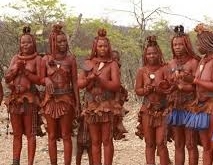Last week, some colleagues at LAC and I attended Authenticized which was a documentary-style film that looked at the social structure and interdependence created when tourists, filmmakers and photographers travel to the Opuwo area (in North-western Namibia), where the Himba, a subgroup of the Herero live. For various reasons, the Himba maintain a traditional culture, living in hut-like structures, covering their bodies and hair with a redish clay, and dressing as they have for centuries-- in a way that leaves their torsos exposed (including the women).
You can see how such a culture is attractive to westerners, who tend to seek out the vibrant colors and traditions of the unknown, and environments that are less sterile. The Himba are seen as exotic, one of the last remaining “authentic” and ancient societies in the world. As such, they are an artist’s/anthropologist’s dream and are bombarded with requests to be filmed, photographed etc. Being somewhat savvy, they do require payment for their photos and presence in films, however it seems that they don’t make a fair amount of compensation given the interference with their privacy and lives. What particularly disturbed me, was the fact that the chief negotiates a price for the entire community, meaning that individuals (particularly women) were not in a position to refuse to be photographed or filmed. This is just another example of how indigenous women do not have agency or decision-making power within traditional communities and traditional justice systems! (See photos below)

-Photo of Himba women, arebbush.com

-Photo, www.pbase.com/
In seeking out these “authentic” communities, many individuals were expecting the Himba to be quite primitive and to function without any modern conveniences. This was of course absurd. Several filmmakers/photographers asked individual Himba to remove things like plastic bags from the frame, and not to wear modern clothing like tee-shirts. They believed that allowing modern items in the shots would make the photo or film “inauthentic.” In doing so, they create a false reality—a perception that traditional societies in Namibia are not modernizing in any way. The Himba comply with these requests, furthering this perception. It seems that their continuing to dress and live traditionally is largely influenced by these relationships, which begs the question whether they would be better off—more able to access quality education, and modern conveniences—if these interdependent relationships did not exist.
Paying money for authentic tradition seems to distort reality even further. Women can make quite a bit of money dressed as traditional Himba on the streets of Windhoek (I have seen quite a few). One expert told an anecdote about one woman who dresses as a Herero (with a distinctive pointy hat and colorful dress) when it is financially convenient and as a Himba (with the clay and traditional clothing) when this is more so. When she runs errands, she dresses in modern clothing. I wonder which of her personas (or the personas of the Himba women I have seen in Windhoek) are authentic...
_large.jpg)
-Photo of Herero women, Wikipedia
Living in the world. Humanitarian. Advocate for health, human rights and equality. Documenting experiences and observations.
